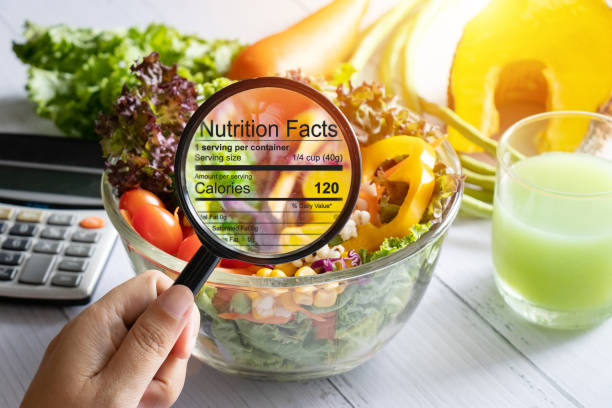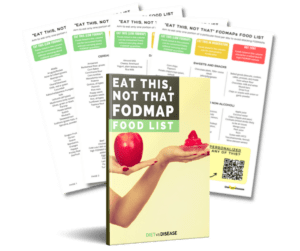Are you still getting bloated on a low FODMAP diet even though you’re following it perfectly? You’re not crazy, and you’re definitely not alone.
Many people have this exact same frustrating experience. They’ve eliminated all the high FODMAP foods, they’re using the Monash app religiously, but that uncomfortable bloating just won’t go away.
Here’s the thing — clinical research shows the low FODMAP diet actually works for up to 86% of people with IBS (1). So statistically, if it’s not working for you, it’s likely user error rather than FODMAPs not being an issue for you.
But it’s not your fault, because there are actually two crucial hidden traps that you probably were never taught, which we’ll dive into in this article.
Here is a video we made, otherwise there is a written version underneath.
The Hidden Ingredient Trap
The first issue is what we call the hidden ingredient trap, and it catches almost everyone off guard. Food labels and products aren’t always what they seem, and this can sabotage your low FODMAP efforts without you realizing it.
Consider this example: chicken salt, one of Australia’s most popular seasonings. The name literally says “chicken,” and many people assume it’s safe because chicken doesn’t contain FODMAPs and neither does salt. However, looking at the ingredients reveals a different story: 80% salt, plus garlic powder, onion powder, and “natural flavoring.”
This innocent-looking seasoning is absolutely loaded with FODMAPs, yet many people would never suspect it based on the name and front-of-package labeling.
A Real Client Example
Margaret, a retired nurse, experienced this exact trap. She had been following the low FODMAP diet for three months, using the Monash app religiously and avoiding all obvious high FODMAP foods like onions, garlic, wheat, and beans. But her bloating wasn’t improving — in fact, some days she felt worse than before starting the diet.
During consultations, her food diary looked perfect on paper. She was eating grilled chicken with rice and carrots for dinner, having appropriate breakfast portions, and choosing all green-light foods according to the app. Her symptom scores, however, weren’t improving.
The breakthrough came when we discovered she was using a seasoning blend on her chicken every day. The front of the package simply said “herb seasoning,” but the ingredient list revealed garlic powder as the third ingredient.
She’d been unknowingly consuming high-fructan foods daily while thinking she was being perfectly compliant.

The Widespread Nature of Hidden FODMAPs
Food manufacturers use garlic powder and onion powder in almost everything.
Even small amounts can trigger symptoms since garlic is high in fructans, one of the key FODMAP groups. These ingredients hide under various names: garlic powder, onion powder, “natural flavoring,” or simply “spices.”
Common culprits include seasoning blends, stock or bouillon cubes, seasoning packets, marinades, sauces, and even seemingly innocent items like rice crackers. Each product adds unexpected FODMAPs throughout the day, none of them obvious when you just look at the front packaging.
Summary: Hidden FODMAP ingredients like garlic powder, onion powder, and “natural flavoring” sabotage diet compliance by appearing in seemingly safe products under deceptive labeling, making ingredient list reading essential for success.
How to Protect Yourself from the Hidden Ingredient Trap
To protect yourself from this trap, you need to develop systematic ingredient-checking habits. Always read the complete ingredient list, looking for any mention of garlic, onion, or their derivatives like garlic salt, garlic powder, onion powder, or onion salt.
Be particularly suspicious of anything labeled “natural flavoring” or “spice blend” without listing specific spices, as these can contain garlic and onion compounds. Pay special attention to high-risk products: stock or bouillon cubes, seasoning packets, marinades, and sauces.
Margaret’s Success Story
Within one week of eliminating all the hidden FODMAP sources we identified, Margaret’s evening symptoms nearly disappeared.
She finally experienced the relief that everyone talks about during the elimination phase — the way the diet was supposed to work from the beginning.
This transformation happened not by changing her core foods, but by removing the hidden saboteurs that had been undermining her efforts for months.
Summary: Systematic ingredient list reading and awareness of high-risk products like seasonings, stocks, and sauces can eliminate hidden FODMAP sources and restore diet effectiveness within days.
The FODMAP Stacking Trap
Even when you master hidden ingredients, there’s another trap that catches people who are genuinely careful with their food choices: FODMAP stacking.
Evelyn, a 70-year-old retired teacher, exemplified this issue perfectly. She was selecting only green-light foods from the Monash app, yet still experienced bloating after every meal. During consultations, her food tracking looked perfect on paper, but her symptoms persisted.
The Coffee Cup Analogy

Your FODMAP tolerance works like a coffee cup — each person’s capacity is different. Some people have a large travel mug that can handle substantial amounts, while others have a delicate teacup that overflows easily.
If you add liquid slowly, drop by drop, even a small cup stays manageable. But pour in too much too quickly, and even a large mug will overflow. This is exactly what happens with FODMAP stacking.
How Stacking Works in Practice
Evelyn’s problematic lunch included small amounts of avocado, almonds, grapes, and chickpeas. Individually, each portion fit within low FODMAP guidelines. However, when combined in one meal, the cumulative FODMAP load exceeded her tolerance threshold.
This stacking effect can occur throughout the day as well. You might have low FODMAP oats and strawberries for breakfast, snack on almonds, then eat avocado and tomatoes at lunch. Each individual food seems appropriate, but the cumulative effect builds until your digestive system reaches its limit.
The Importance of Timing
Your gut needs time to clear FODMAPs from one meal before processing the next load. Eating moderate FODMAP foods in quick succession prevents this clearance, leading to an accumulation effect that triggers symptoms.
Additionally, everyone’s tolerance varies significantly. Your threshold might be much lower than someone else’s, explaining why identical meal plans produce different results for different people.
Summary: FODMAP stacking occurs when multiple low-FODMAP foods consumed together or in quick succession exceed individual tolerance thresholds, requiring personalized spacing and combination strategies.
If you’re just getting started, download our free Low FODMAP food list to get clarity on common gut triggers
Tap the blue button below to download our “Eat This, Not That” list as well as additional resources for bloating (it’s free!)

How to Avoid the FODMAP Stacking Trap
To prevent stacking, use the Monash app more strategically than simply checking green versus red classifications.
Examine the actual FODMAP types present in each food. If you’re consuming avocado (which contains sorbitol), consider avoiding stone fruits later in the day since they also contain sorbitol.
Similarly, if you’re having rolled oats, be cautious about adding other oligosaccharide-containing foods to the same meal. This approach helps prevent overloading any single FODMAP category.
The Importance of Comprehensive Tracking
Track symptoms across entire days, not just individual foods.
This broader perspective allows you to identify patterns and connections that single-meal analysis might miss. Professional guidance can be invaluable for connecting these dots and identifying your personal tolerance patterns.
Evelyn’s Success with Spacing
Rather than eliminating foods entirely, Evelyn learned to space out her FODMAP intake throughout the day. She could often eat the same foods in the same total amounts, but distributed them so her digestive system could handle the load more effectively.
Within two weeks of implementing these timing and combination strategies, Evelyn’s bloating significantly improved. The solution didn’t require additional food restrictions — just smarter timing and combinations based on her individual tolerance patterns.
Summary: Successful FODMAP management requires understanding individual tolerance patterns, strategic timing of FODMAP-containing foods, and comprehensive symptom tracking to identify personal trigger combinations.
When Low FODMAP Isn’t the Complete Answer
While clinical research shows the low FODMAP diet works for up to 86% of people with IBS, this leaves 14% for whom low FODMAP is not the complete solution.

For these individuals, the problem isn’t necessarily what they’re eating, but what’s happening inside their bodies that makes them react to even the safest foods.
Additionally, sometimes the real issue involves factors like chronic stress and anxiety, often referred to as the gut-brain connection, or a highly sensitive vagus nerve. These physiological responses can make someone reactive to foods that should theoretically be well-tolerated.
The Need for Comprehensive Approaches
Understanding these limitations helps explain why some people continue experiencing symptoms despite perfect dietary compliance. It also highlights the importance of considering broader factors beyond food choices when addressing digestive issues.
Summary: Approximately 14% of people with IBS symptoms may not respond fully to low FODMAP approaches due to underlying factors like stress, anxiety, or vagus nerve sensitivity that require additional therapeutic strategies.
Bringing It All Together
If you’re still experiencing significant symptoms on low FODMAP despite following it “perfectly,” you’re likely falling into one of these two hidden traps:
Trap 1 — The Hidden Ingredient Trap: Garlic powder, onion powder, and “natural flavoring” are sneaking FODMAPs into your supposedly safe foods through deceptive labeling and ingredient lists you’re not checking thoroughly enough.
Trap 2 — The FODMAP Stacking Trap: You’re eating only green-light foods, but you’re combining too many of them in one meal or consuming them too close together, exceeding your individual tolerance threshold.
The Path Forward

Success with the low FODMAP diet requires more than just following app recommendations.
It demands careful ingredient analysis, understanding of individual tolerance patterns, and strategic meal timing.
Most importantly, it requires recognizing that perfect dietary compliance doesn’t guarantee symptom resolution if underlying factors like stress or nervous system sensitivity are involved.
Summary: Low FODMAP success requires mastering both hidden ingredient detection and personal stacking tolerance, while recognizing that some individuals may need additional approaches beyond dietary modification.
What Should Your Next Steps Be?
If you’ve been frustrated by persistent bloating despite careful low FODMAP adherence, it’s important to know that you can identify and overcome these hidden traps that may be sabotaging your progress.
With the right comprehensive approach, you’ll start to notice how systematic ingredient checking eliminates unexpected symptom triggers, how strategic meal timing prevents FODMAP overload, and how understanding your personal tolerance patterns allows for more food variety without symptom return.
If this feels like the missing piece in your low FODMAP journey, professional guidance can help you identify these subtle but important factors.
To learn more, I invite you to apply for a nutrition assessment call with us. We’ll help you make sense of what’s really happening beneath the surface and map out the next steps to get you feeling better — not just temporarily managing symptoms, but addressing the root causes for long-lasting relief.

How much???